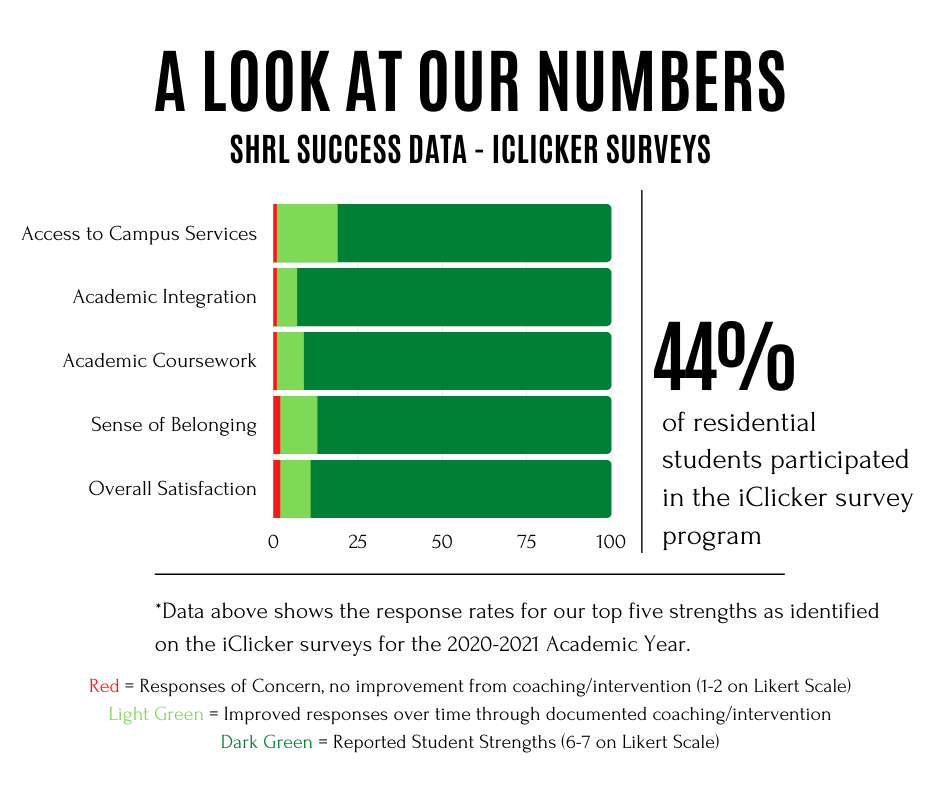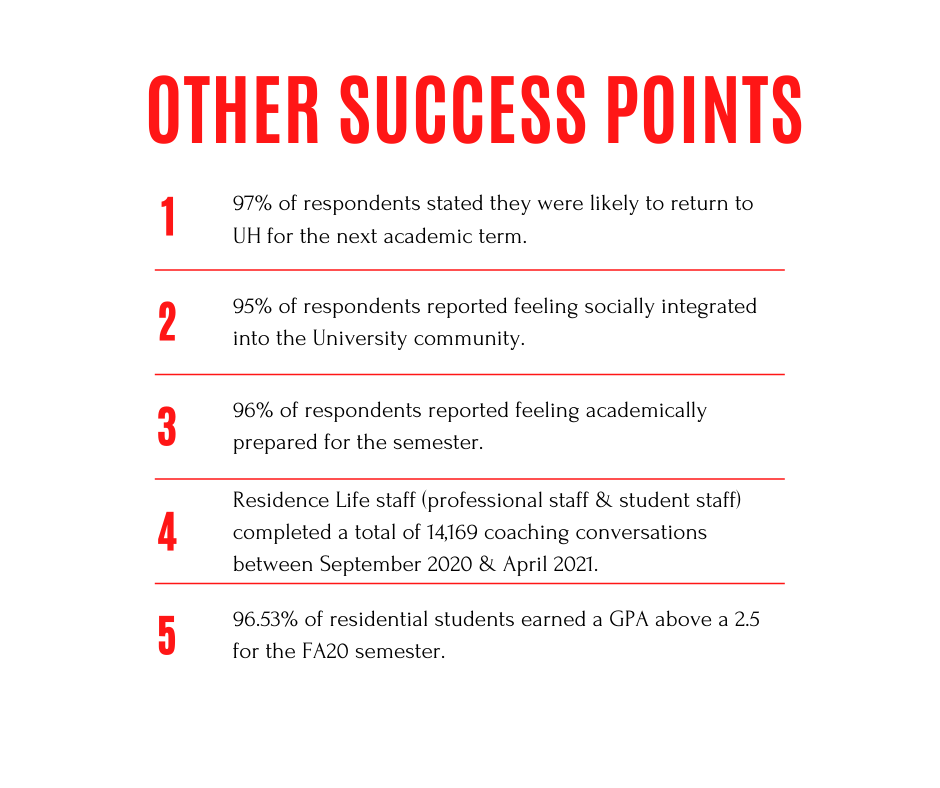
New Residential Engagement Model helping students living on-campus
DSAES News
July 21, 2022
Student Housing and Residential Life is shaking up the programming residents see when they live on campus — and it’s helping staff identify students at risk of dropping out or other impediments to their academic success.
Despite the pandemic last fall, Housing staff rolled out a new Residential Engagement Model, a new curriculum concept that has emerged in on-campus residential living over the past decade. Just starting to truly spread throughout universities across the country, the University of Houston has already become a showcase for this new model, which creates new, specialized programming for students living on campus that not only focuses on key learning goals, but also helps staff identify students who need more help.
SHRL staff have been working on its model for a while, finalizing the plan in Spring 2020 and rolling it out in Fall 2020. Using the iClicker platform, they say the Residential Engagement Model’s first year was a success, and they are optimistic for the 2021-2022 academic year as more students are back living on campus.
Alyssa Veteto, assistant director of residential life, answers questions about this new model.
Student Housing and Residential Life has been working on developing a Residential Engagement Model for a while. Tell us how it went from planning to reality.
Prior to the development of the Residential Engagement Model, the department had a programmatic approach in place that changed year to year. We had been collecting student success data and developed an interaction-based model to respond to the student success data we were collecting. Programs were then developed in response to the data as well. Knowing that our approach had been largely reactionary, we were looking to find methods to be more proactive when considering student success intervention.
We included a goal in our strategic plan developed during the 2018-2019 year that we would enhance and evaluate our existing Community Development Plan. This goal within our strategic plan was really the starting point for our revision and development of the Residential Engagement Model. During the 2019-2020 year, we started doing an “archaeological dig” into our institutional and departmental documents. This process included pulling mission statements, strategic planning documents, survey data, student success data, student demographic data, and theoretical models and frameworks and identifying the common themes and priorities that came to the surface.
Using the information from the archaeological dig, we developed an educational priority statement that is the true foundation of the Residential Engagement Model and answers the question of what students should learn as a result of living on campus at the University of Houston. From the educational priority we identified three learning domains — Learn, Discover, Empower — and we wrote learning outcomes for each domain. With all of the learning outcomes developed, we created a rubric that provides a benchmark of what achievement of each learning outcome looks like at a Beginner, Intermediate, and Advanced level. This rubric allows for all of our educational interventions to be sequential and to build off the learning that has occurred previously.
Additionally, it was designed to be a tool for staff to help identify deficiencies or areas needing improvement for individual students. Once all of the foundational documentation was written, our live-in professional staff received extensive training on the model and on how to develop and write lesson plans using the learning outcomes and rubric. In Fall 2020, we began the first implementation of the Residential Engagement Model, with the expectation that this was only going to be implemented at about 15-20 percent given the uncertainty of the pandemic. With this rollout, staff were expected to complete one Residential Engagement Model program per month over the course of the year. Many communities ended up doing more than that, but this was our starting point.
How many programs did SHRL do after the rollout last fall?
For the 2020-2021 academic year, our staff implemented a total of 84 active or virtual programs under the Residential Engagement Model. These include topics from any of the learning domains/outcomes outlined in the model. Additionally, the staff hosted about 80 social/relationship-building programs each semester. Every RA was required to complete one passive educational program per month — about 130 passive initiatives per month across the system.
Our biggest programmatic piece with the Residential Engagement Model were the individual coaching conversations that student staff and professionals were conducting with residents 1:1. Between September 2020 and April 2021, our staff documented a total of 14,169 individual conversations with residential students on student success topics ranging from course struggles and class attendance to homesickness and financial concerns.
What kind of feedback have students given on the new model?
The general feedback shows students find the programming to have more purpose, and student staff are getting more structure to their role and how to engage with their residents in meaningful ways. Some of our best points that demonstrate that students are learning and that this model has made a difference is through the iClicker survey data.
One specific example that we identified early on was students knowing how and when to access campus services (i.e. CAPS, LAUNCH, Financial Aid, etc). We intentionally focused all Residential Engagement Model programming in August/September on how to access campus resources and what those services could do to assist students. We launched our first iClicker survey in mid-late September and found that only 1 percent of respondents indicated that they did not know how to access campus services online and in-person.
Based on what we are seeing in the data with statistics of that nature, students were getting and retaining this information.
How are you incorporating the iClicker results into the Residential Engagement Model and/or other SHRL programs to help students succeed?
The iClicker Insights survey program has really become the foundation for all of our student success intervention processes. The data provides us with a starting point for identifying students who are struggling in and outside the classroom. The data influences not only which students we are targeting for intervention, but also helps our staff identify trends within the larger population that we can address programmatically.
You assign students a risk score. How do you help students at risk of dropping out or other problems?
Once we receive data for a student in the responses to a survey, we assign a risk indicator (red, yellow, green). Our red students are primarily those that have responses of concern that are a 1 or 2 on the Likert scale out of 7 (other factors could influence this risk indicator like GPA, behavioral concerns, or concerns reported by a staff member that are not included in the survey questions).
Yellow students are those that have responses in the 3-5 range on the Likert scale, and green students are those indicating high-level or high-functioning responses (6-7 on the Likert scale). Students with a red risk (high risk) indicator are sent to our professional staff for individual follow-up, and those with a yellow risk indicator (medium risk, sometimes on the verge of becoming high risk) are referred to our Community Mentors (this is a student staff position that receives specific training on supporting academic and social student success through programs and intervention).
Staff should be reaching out to their assigned students within 48 hours of receiving notification to set up a 1:1 meeting to discuss their survey responses and make referrals to appropriate campus resources/services. Following a student success/academic intervention meeting, staff typically follow-up with the student check in on their progress.
Has there anything in the iClicker results that was worrying? Positive?
We definitely had both some concerning and some very positive data from the iClicker surveys. Our top five reported concerns, top 5 strengths, and some other positive data points that were reported by students can be seen here: 

What are your plans for Fall 2021 and beyond?
For Fall 2021, we are preparing to launch the Residential Engagement Model at 100 percent, pending any unforeseen issues with COVID. The staff have engaged in extensive training. We’ve added some additional educational planning components to the Residential Engagement Model structure so that professional staff can forecast the programmatic pieces that they will implement each semester and can really look at how they can sequence the learning objectives in a way that optimizes the full educational plan. We are rolling out a training for our Desk Assistants regarding the Residential Engagement Model. This will be the first training for these staff members on the Residential Engagement Model.
We are in the process of developing an Academic Intervention protocol that incorporates some more detailed reporting about the coaching conversations so we can better track each student’s success points more intentionally. We’ve added some components to the resident interaction forms that our student staff fill out that allows those staff members to request follow-up from a RLC or CM if a student needs additional support.
We’re being much more intentional with the timing and sequence of the survey launches across this academic year to help us better tell the story of our students’ learning. Looking more long term, we are really working to develop a consistent cycle of assessment with some built-in feedback loops that can help us look at our student success data at both a macro and micro level. Ultimately, we are wanting to develop a truly robust system of support for students that continuously builds from the first-year experience through graduation.
Over the 2020-2021 academic year, SHRL staff held:
-
84 active or virtual programs
-
80 social/relationship-building programs
-
14,169 individual conversations with residential students on student success topics
In iClicker Surveys, students reported:
-
18% had health-related stress
-
17% were struggling with their courses
-
9% had class attendance problems
-
7% were having trouble with academic motivation and finances